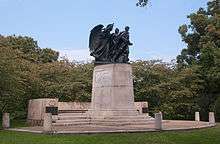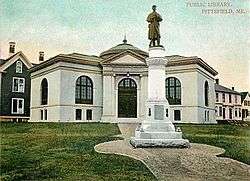Albert Randolph Ross
Albert Randolph Ross (October 26, 1868 – October 27, 1948) was an American architect. Born in Westfield, Massachusetts, he was a son of architect John W. Ross.
Albert Ross attended grammar school in Westfield and later in Davenport, Iowa, where he went on to high school, finishing in 1884.[1] After working as a draughtsman in his father's Davenport architecture office from 1884 to 1887, he spent a year working for an architect in Buffalo, New York, before joining the New York City firm of McKim, Mead and White in 1891.[1][2] After leaving that firm in 1897, he started the firm of Ackerman & Ross, which operated from 1898 to 1901.[2]
In 1927, when he was awarded a $10,000 prize in a competition to design a new courthouse for Milwaukee out of 33 who submitted proposals,[3] he told the Milwaukee Journal why he settled on a traditional design:[4]
When I went into the competition I considered whether to design a building in the modern and experimental trend for a great public courthouse. I made modern sketches, but in my opinion they fell flat for this purpose. They were not typical and expressive of public work, so I turned to that type established by our forefathers.... I have no quarrel with trends in modern architecture. I take a fling at it myself. But it simply won't do for public buildings. It violates the dictates of a definite style built up through one hundred and fifty years of our history. A departure into modernism would not be suitable for a courthouse. We must be trained slowly to things violently new. The public's money cannot rightly be used to force experiments down its throat.
In 1901, Ross married Susan Husted, from Brookline, Massachusetts.[1] From 1901 until 1948 his main residence was on Negro Island, near Boothbay Harbor, Maine.[2] He died October 27, 1948.[2]
Works

.jpg)

Among the buildings that Ross designed were 12 libraries.[2] Some of his notable design projects included:
- Gloversville Free Library, Gloversville, New York, Beaux Arts building listed on the National Register of Historic Places (NRHP)[5]
- Pittsfield Public Library, Pittsfield, Maine; NRHP-listed for its architecture[5]
- Columbus Metropolitan Library, Columbus, Ohio, formally known as the Carnegie Building[1][2]
- Carnegie Library, Denver, Colorado; now known as the McNichols Civic Center Building[1][6] (1910)
- East Orange Public Library, East Orange, New Jersey[7]
- Union County Courthouse, Elizabeth, New Jersey[1]
- Carnegie Library, Washington, DC,[1] also known as Central Public Library, now the Historical Society of Washington, D.C.[7] Mount Vernon Sq., 8th and K Sts., NW. Washington, DC, an NRHP-listed work of Ackerman & Ross
- Exterior design for Draper Hall, State University at Albany, Albany, New York[8] (1909)
- Milwaukee County Courthouse, Milwaukee, Wisconsin[2] (1931)
- Carnegie Library, Good Will Home Association, Hinckley, Maine
- Montclair Art Museum, Montclair, New Jersey (1914)
- Needham Free Public Library, Needham, Massachusetts[9] (1904)
- Old Town Public Library, Old Town, Maine[10] (1904)
References
- 1 2 3 4 5 6 7 John William Leonard, Albert Nelson Marquis. Who's who in America, Volume 4: Albert Randolph Ross.
- 1 2 3 4 5 6 7 Columbus in Photographs: Albert Randolph Ross
- ↑ "Architect Here Wins $10,000 Prize". New York Times. August 4, 1927. Retrieved February 11, 2015.
- ↑ Wright, Frank Lloyd (1943). Frank Lloyd Wright: An Autobiography. Duell ,Sloan and Pearce. p. 358.
- 1 2 National Park Service (2009-03-13). "National Register Information System". National Register of Historic Places. National Park Service.
- ↑ Former Carnegie Library, Denver
- 1 2 "Library History". Port Jervis Free Public Library. Archived from the original on 2011-09-14. Retrieved 2011-10-04.
- ↑ Draper Hall, M.E. Grenander Department of Special Collections and Archives, University Libraries, University at Albany
- ↑ Needham Free Public Library, accessed February 11, 2015
- ↑ Old Town Public Library, accessed February 11, 2015